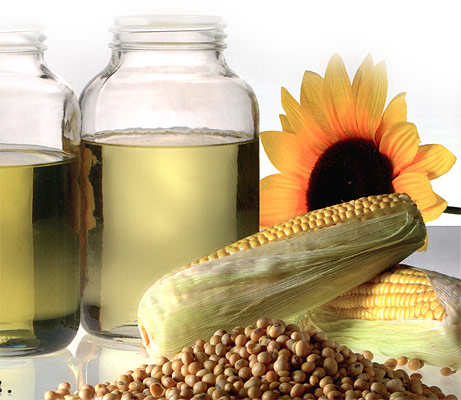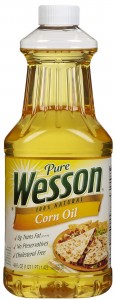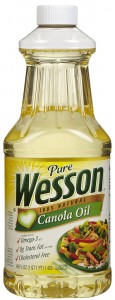What do you really know about the cooking oils you use in your home?
I used to think that they were all pretty much the same, so I would just buy whatever off-brand was on sale. I mean, I thought that olive oil was probably the best, but that purchase was reserved for a special treat. I mean, it’s expensive!
I am cautiously optimistic about this post. I hope that I can be concise enough to get an important message across, yet powerful enough in my written words to make an excellent case for the truth…all while not scaring you away. Ha! I want to make this simple. Let’s start by looking at the most common cooking oils.
What Are My Cooking Oils?
Vegetable Oil–
This is just what it sounds like…oil from vegetables. What vegetables? Among others, you will find a blend of soybean, sunflower, and corn oils.
Corn Oil–
Just as it sounds, corn oil comes from pressed corn. Corn oil is low in both saturated and monounsaturated fats.
Canola Oil–
Canola oil is not like the other oils, in that you cannot find it in its original form in a field. Canola oil would be better suited to be called rapeseed oil, as it comes from a plant called Brassica napus (rapeseed being its common name). This is a plant from the mustard family, which is related to bok choi and turnips. (I guess this is why my son is allergic to both mustard and canola oil).
Many people (I used to be one!) think that this is the healthiest of the cheaper oils because it is being touted as an oil with low saturated fat content and high monounsaturated fats, meaning that it could help reduce the risk of heart disease..
Olive Oil–
Olive oil is touted as the healthiest of the “typical” oils on the market. It comes from pressing olives from olive trees. Olive oil is high in monounsaturated fat, again, good for lowering risk of heart disease.
Basic Truths Of Cooking Oils
Okay, so now you know what the common oils you will find at any supermarket really are. Let’s dig a little deeper and uncover some more truths about these oils.
Cooking Temperatures (smoke points)–
Oils perform differently at different temperatures and each oil has what is called a “smoke point.” Free radicals (which contribute to many ailments, including cancer) are let loose in large amounts once an oil reaches its smoke point, meaning that it is no longer safe for consumption.
It’s hard to say what temperatures you are using on your stove (anywhere from 200 to 450 degrees), but you can certainly tell what temperature you are using in your oven. Here are the smoke points for the oils listed above…
- Vegetable Oil- This depends on what oils are present in the mix. Typically, vegetable oil contains sunflower oil (and most cooking oils in this category are refined), so this would make the smoke point about 400 degrees.
- Corn Oil- Again, usually refined, the smoke point would be about 450 degrees.
- Canola Oil- Refined canola oil has a smoke point of about 400 degrees.
- Extra Virgin Olive Oil- Smoke point of about 320 degrees.
If we are looking at only smoke points, the winner in this category would be corn oil and the loser olive oil. If you are a *real food foodie* &/or have been following my blog you might be thinking to yourself, “Okay, but it’s not really a winner though, is it? I thought that corn was bad?” Good job, my foodie detectives! Let’s now go down that path.
GMOs–
Remember these little boogers? Grr. They are finding their way into practically everything on our supermarket shelves. The oils listed above? Yup…all at risk for being GMO “foods.” Corn and soybeans are the most commonly grown genetically engineered crops in America (upward of 90% for both crops are genetically engineered). This means that I won’t touch these oils ever again.
Health consequences of eating GMOs is simply not known. For example, remember when a few chip brands (WOW! Chips, Pringles Fat-Free, Lay’s Light Chips) hit the market back int he 90s? They contained a new ingredient…Olestra (or Olean). Olean was sold as a fat substitute that would add no fat, calories, or cholesterol to products. Sounds good, right? Not so good when people started having horrific side-effects, including leaky gut (loose bowl movements because of excess fat in the stool), abdominal cramping, and weight gain (yup, weight GAIN).
Point is, GMOs are very new to our world. We simply do not know enough about how they work in our bodies (and our environment). If they truly aren’t bad for us, why are corporations (read: MONSANTO) so afraid of labeling them??? Anyway, I will not use these oils for fear of GMO contamination in my body. No chemicals for this girl and her family!
Polyunsaturated Fats (PF)–
Vegetable, corn, and canola are all polyunsaturated fats (olive oil is monounsaturated). These PF appear to be all of the rage now, huh? Many experts say we should eliminate traditional saturated fats (i.e. real butter, lard, coconut oil) from our diets and replace them with these laboratory made PF.
PF are very unstable (as mentioned briefly above re: their heat points). Further, these oils contribute to free radical damage in our bodies, which has been linked directly to heart disease, Alzheimer’s, autoimmune diseases (for me…eczema!), cancer, and early aging.
It is also important to note that PF are omega-6 fatty acids, which hamper our body’s ability to properly process very important omega-3 fatty acids. Too many Omega-6 fatty acids basically push out omega-3 fatty acids, which can lead to blood clots, poor immunity, poor digestion, and even cancer.
Well, What Am I Supposed To Eat???
Haha…I went all doomsday on you there again, didn’t I? I have a problem with doing that sometimes. Never fear…I will never leave you hanging! I will always present you with a healthy, real food alternative. So, should you still use these oils? Well, that is up to you. I will say that the only one I will ever use is organic virgin olive oil (from a very reputable, well-researched source) and even then, never for cooking. I use it often in sauces and on salads (especially mixed with ACV, sea salt, and white pepper…yum). So, what do I use for cooking?
What was around long ago when our great grandparents (and even grandparents for some of us) were cooking? Traditional fats, such as real butter and lard.
Would I really use such things…sinful saturated fats…in my cooking? Aren’t they supposed to be horrible for you!?
Funny…(to name only a few) our ancestors had much (MUCH) lower rates of obesity, heart disease, allergies, asthma, and Alzheimer’s. So, really…would I actually use and eat the saturated fats our ancestors eat (and the medical community tells us today NOT to eat)?
I answer that with a resounding…YES, each and everyday!
I’ll explain why in my next post. Until then…
xoxo,
Jess, aka Scratch Mommy
This post was shared at– Simple Living Wednesday, Share Your Solutions On Thursdays, The HomeAcre Hop.




Comments 5
What do you think of grapeseed oil? I have been using this since a neighbor related it’s healthful benefits, one including that its smoke point was very high, 500 degrees or more. My research seemed good on it at the time, but I can see you’ve been very in depth, so I would appreciate your opinion.
Hi Nica,
Thanks for your comment. Yes, I have spent a lot of time researching and talking with people about various oils. That said, I have not used Grapeseed oil, but I can still make a somewhat educated judgement based on my understanding of the oil.
Yes, you are right that the smoke point is actually very high. Therefore, you would assume that it’s okay for cooking. However, Grapeseed oil is a mainly polyunsaturated fat. This goes back to the stability of the oil, and this one would not be very stable. I think it’s one of those where if you use a small amount occasionally (still at low temperatures), you’d likely be a-okay. For me, I just steer clear of cooking with any oils that are mainly polyunsaturated in composition.
I hope that this helps. Now…questions for you, if you don’t mind! Can you tell me what Grapeseed oil tastes like? Looks like? Smells like? Since I have never used it myself, I’m curious. 🙂
Thanks again for your comment,
Jess
Thank you for your answer! I was not clear on the science of it all. When I first started looking for it, you could only find grapeseed oil in the kosher foods section of the store. I guess it has been used in the Mediterranean forever as it is a byproduct of winemaking, but it is becoming easier to find in the US because it is supposedly HDL-promoting and lowers LDL cholesterol. It is yellow to greenish colored, I think the greener is supposed to be more pure, like olive oil. But unlike olive oil it has almost no smell or taste that alters flavors of food. So you can use it in baking as well as in salads and frying. (But I guess only carefully and at low temperatures! Which is not good for me, one who can scorch water!) I still will prefer it for raw oil usuage, like for making tabouli, which I often do, or mixed with dipping spices for bread, or salad oil. Not having been raised on it, olive oil can be overwhelming sometimes.
Except – now I see about the Omega 6. Is this why my doctor is nagging me to take cholesterol meds? How can it be “proven to raise your HDL” and full of Omega 6 at the same time? I am officially confused.
I like using lard and butter 🙂 Thanks for sharing this on The HomeAcre Hop! Hope to see you tomorrow night at:
http://www.theselfsufficienthomeacre.com/2013/03/the-homeacre-hop-11.html